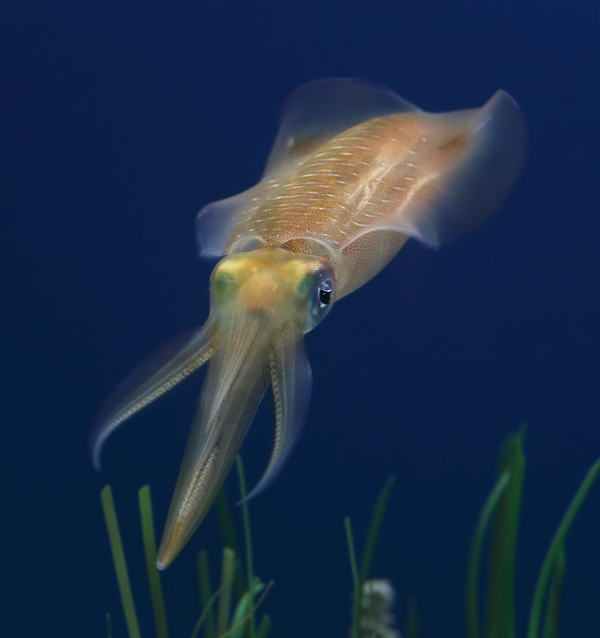Flashy tropical octopuses are all showing up for work. The world's smallest cephalopod is on the billing. Even specimens of the deep sea are likely to make an appearance.
So who's the diva too delicate to display? Local squids.
That's right. Two species that live in the Aquarium's backyard, market squid and Humboldt squid, are apparently anti-exhibitionists.

California's market squid (Doryteuthis opalescens) has been frustrating attempts to display it since the Monterey Bay Aquarium opened in 1984. The ultimate West Coast free spirit. (Joshua Sera/Flickr)
As a California squid biologist, I take a perverse sort of pride in that. Although, our geography's not really special, it's just that our two squid species happen to be pelagic: inhabiting the vast blue expanse of open ocean, rather than hunkering down in the sand or hanging around seaweeds.
It's a lot easier to fill a tank with sand or seaweeds than to recreate the open ocean environment in something that isn't, well, open. Still, the Aquarium has managed to display other pelagics, like tuna and jellies. The problem is that squids are both fast and active like tuna AND soft and delicate like jellies. They're likely to brush against a wall or filter, and that's likely to lead to injury, infection, and death.
So the only squids* that will show up in "Tentacles" are benthic, like the dear little pygmies who glue themselves onto seagrasses. It's at once frustrating and awesome to learn that some animals are just too wild to be displayed.

Bigfin reef squid tend to hang out near rocks and coral rather than in the big blue, a habit that will allow them to be featured in the Monterey Bay Aquarium's new Tentacles exhibit. (Randy Wilder/Monterey Bay Aquarium)
* When I'm talking about more than one species of squid, I call them squids. I picked up the habit from ichthyologists, who refer to multiple individuals of the same species as fish ("I saw ten tuna fish today") and multiple individuals of different species as fishes ("Tuna and sharks are both pelagic fishes").
But the full title of "Tentacles: The Astounding Lives of Octopuses, Squid, and Cuttlefishes" features a different choice. The Aquarium's communications director told me that this was discussed in great depth, but wasn't able to tell me the rationale behind the final decision.
As long as I'm quibbling semantics, I can't help noting that octopuses don't technically have tentacles. Squids and cuttlefishes have eight arms and two tentacles; octopuses have eight arms and zero tentacles. I guess "Arms" doesn't sound so exciting. Plus the exhibit includes nautiluses (even though they're snubbed in the title), which have 60-90 tentacles and zero arms. A truly inclusive title would have to be "Arms and Tentacles" . . . or, as my husband suggested, "Appendages." Now that's a crowd draw!





Comments